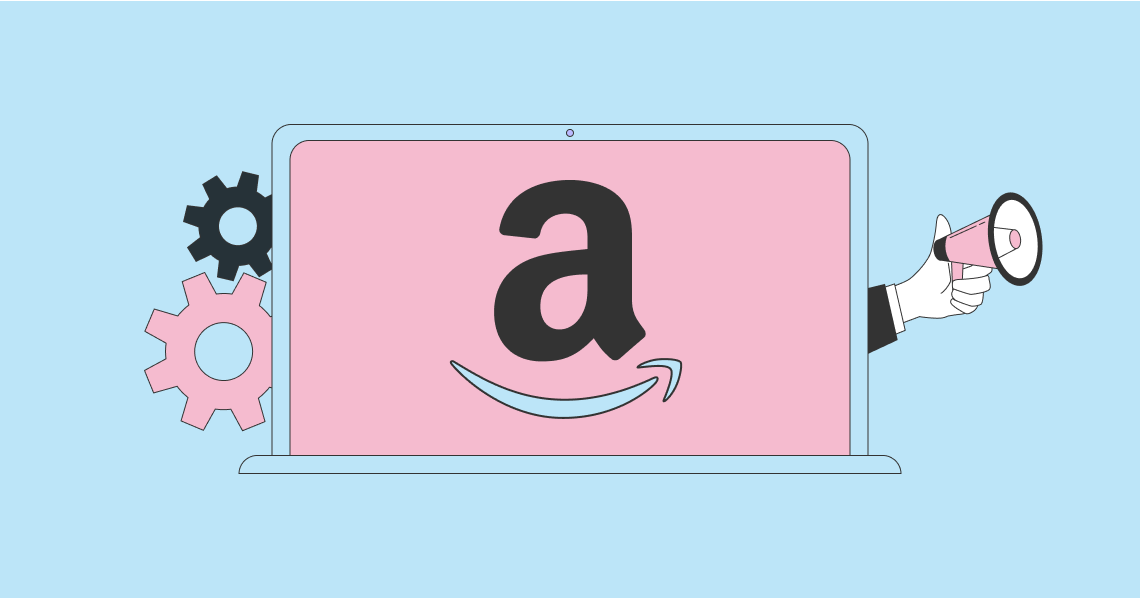Unlike many of the other steps in starting a business, customer acquisition remains important at each phase. You’ll never be able to say that you are completely done with acquiring customers, even if you’re in your 10th year of operation (at least not if you want to scale and stay profitable).
It’s also one of the biggest pain points for businesses. It doesn’t matter if you’re selling the best product or offering an essential service, it’s not a given that you’ll have enough customers to help your business stay profitable. You actively need to create awareness and motivate your target audience to buy your products continuously. To help you, we’ve summarized all the basics you need to know about customer acquisition and included the most common strategies that you can use.
Customer Acquisition 101: The Essentials You Need to Know:
How Does the Customer Acquisition Funnel Work?
Customer acquisition refers to getting potential customers to buy your products or pay for your services. In short, it’s how your business gets new customers. This is done by implementing a stage-by-stage process that you can repeat – the customer acquisition funnel.
With the help of the customer acquisition funnel, you can better visualize your potential customer’s journey. Typically, there are three primary stages that you need to pay attention to: awareness (top of the funnel), consideration (middle of the funnel), and purchase (bottom of the funnel).
Your first step is to create awareness about your brand and its offerings among your target audience. This will include targeting people who don’t necessarily have any clear intention to buy your products. In other words, your content will speak to a bigger audience.
Once prospective customers have completed some sort of action, like subscribing to your newsletter, they’ve “graduated” from the top of the funnel and moved to the middle of the funnel. This means that they’re now giving your product or service more consideration. Your job is now to motivate them to complete an actual purchase.
Though, let’s be honest, simply signing up for a newsletter is still a long shot from making a first purchase. There are stronger actions, like adding a product to a shopping cart, that shows much clearer buying intent. Once prospects have completed such a type of action, they’ve reached the bottom of the funnel. It’s the last stage before becoming a customer. At this stage, brands typically use incentives like promo codes or free shipping to clinch the sale.
If you take only one thing from this explanation of the customer acquisition funnel is that it should never be your goal to push a sale every single time. It might sound counter-intuitive when your goal is to drive more new sales, but depending on where your prospective customer is in the funnel, sharing, for example, a simple blog post with valuable content is more than enough for now.
Creating a Strategy for Customer Acquisition
1. Identify your target audience and goals
Identifying your target audience or ideal customer is actually one of the first steps that you should’ve completed when you started your business. So, you’re supposed to have this information already.
The reason why this information matters again when creating a customer acquisition strategy is that it will help you to create content that they will find engaging. What are your customers’ pain points? Where do they usually go when they’re searching for information? What are their demographics? These are just some of the questions you should ask yourself when (starting a business) and creating a customer acquisition strategy.
Armed with better insight into who you’re actually targeting, you can identify your aims. Sure, it’s to get more customers, but what else? Make it more specific.
For example, at what rate do you want to acquire new customers? Is your main goal to create more awareness about your brand? Do you perhaps want to introduce a new product? If your goal is clear, it will be easier for you to communicate the right message.
2. Select your channels or method
To get new customers, your brand needs to be active on the channels that its target audience uses frequently. From Facebook to referral programs, there are a number of channels and customer acquisition methods that you should explore to keep your target audience engaged at every stage of the purchase journey.
Depending on which channels you choose, you’ll also need to adjust your content and strategy. For example, paid advertising on social media channels need captivating visuals, while blog posts for SEO purposes are all about the right keywords and not so much the visuals.
3. Create a strategy for the different channels
When you’re creating a strategy, look at what type of content your ideal customers find more engaging. For instance, do they interact more with long-form blog posts or short videos? What type of content do your competitors typically post? For your strategy to be effective, it needs to be built around the content that your target audience actually wants to see.
4. Decide on a budget
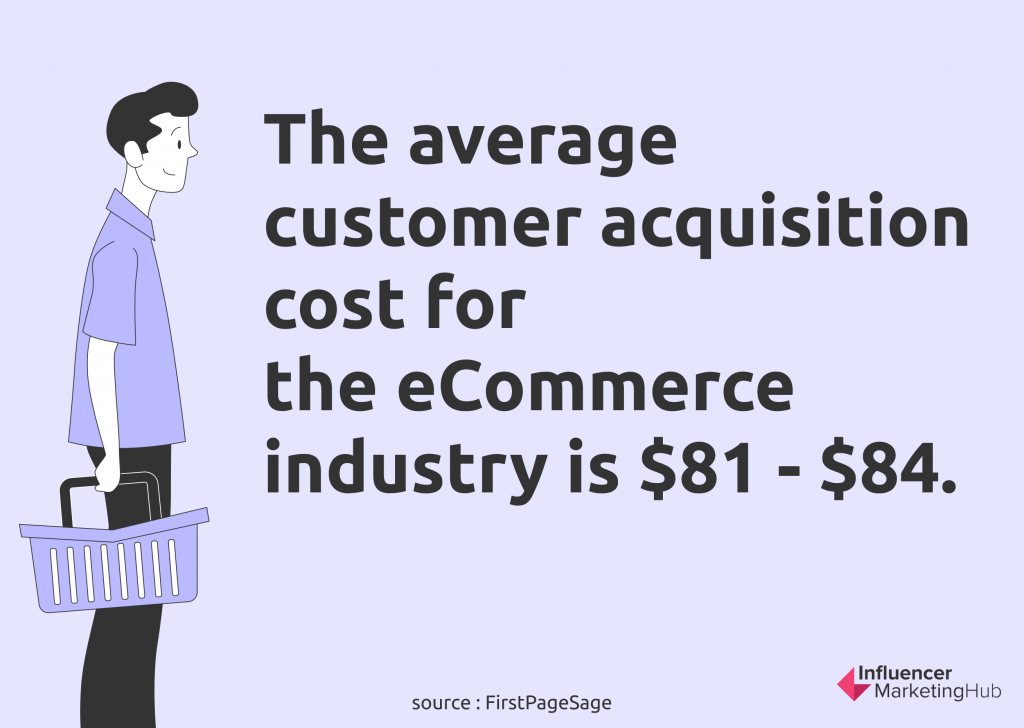
Without a budget, it’s very easy to spend a small fortune on marketing. If you’re completely new to this, it’s better to begin with a modest budget and increase it once you start to see results.
If it’s not your first marketing campaign and you were smart and kept the analytics, you can use this information to work out your customer acquisition cost (more about this later) and use this number as a guide. By knowing how much you need to spend on getting a new customer, you’ll be better equipped to work out your marketing budget.
5. Measure and adjust
As there are many different factors that can impact the process, it’s crucial that you measure and analyze the results. Without this data, you’ll have no idea of knowing where to make changes, let alone if your efforts are actually working in the first place.
So, you’ll want to keep track of a couple of metrics such as your customer acquisition cost, customer lifetime value, and new customer growth. Online businesses that are selling subscriptions will also want to measure its churn rate. With this information, you can work out at which rate customers are canceling their subscriptions. For instance, if you find that female customers are converting more and responding better to Instagram posts, you’ll want to free up some of your budget so that you can spend more on this channel.
Which Strategies Can You Use?
The good news is that there are several strategies that brands can use to help customers move down the funnel. What’s more, digital marketing makes it a lot simpler to measure the results and identify the most sustainable customer acquisition strategies.
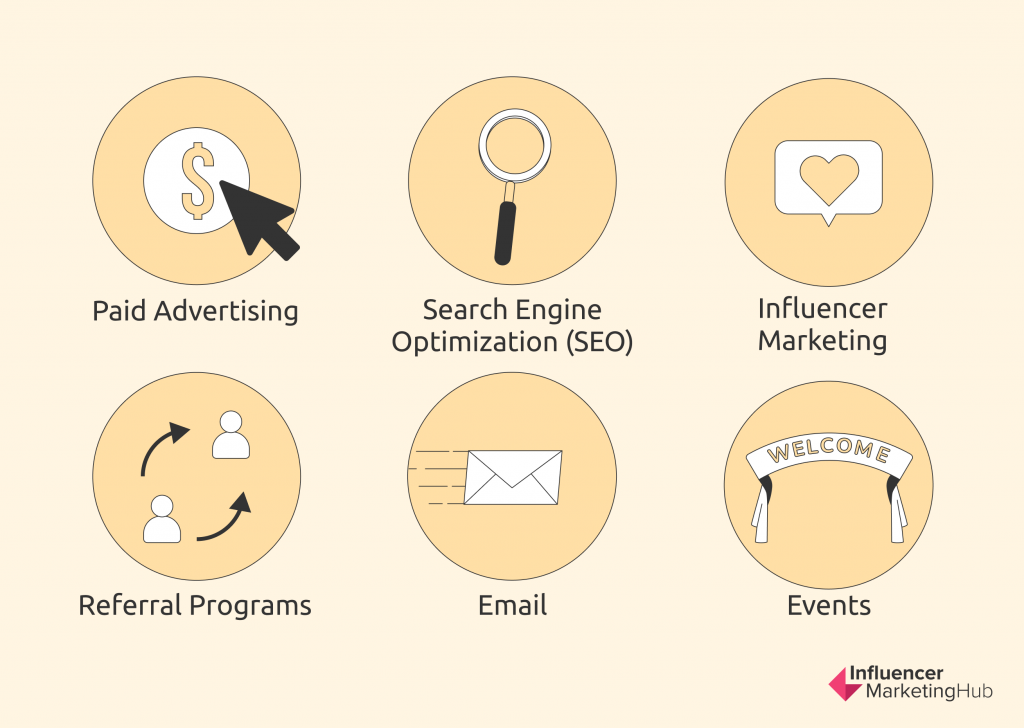
Paid advertising
Online advertising is one of the most common strategies that brands use to get new customers. As avenues like Google Ads and Facebook Ads are tried and tested and offer a lot of measurement tools, it makes it easier to improve your marketing. Ultimately, your target audience will determine which platform would be the best to use for paid advertising. After all, it’s of no use to focus mostly on Google Ads if they use Instagram most of the time.
In short, most paid advertising platforms charge you based on how many times your advertisement was seen (aka user impressions). For example, Google Ads work by displaying your ads to relevant people who searched for a specific keyword.
This can become quite expensive. So, you’ll have to, for example, improve the average order value to make it a cost-effective strategy.
Though, you can generally use criteria, such as demographics, to make your target audience more specific. It’s this targeting ability that’s one of the biggest perks of using paid advertising as your leads will be more relevant and more likely to convert into customers.
All things considered, paid advertising is one of the best ways to grow your business, especially if you have loads of videos and photos and a substantial marketing budget. Your brand will get publicity, usually without huge upfront costs.
Search engine optimization (SEO)
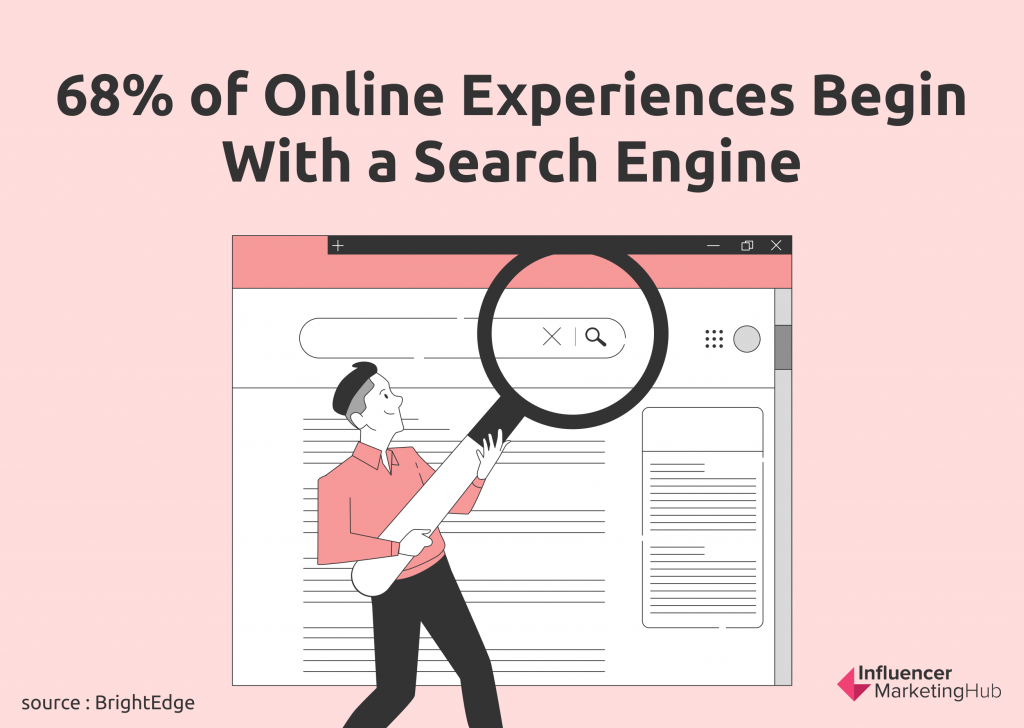
While social media is growing in popularity, Google is far from dead. Many people still turn to Google first when searching for a specific product. So, it still pays to design your website around relevant keywords to help you rank higher in the search results. What’s more, your website content can get you good rankings for a long time to come, unlike paid ads that run for only a short period of time.
Though, unlike paid ads, relying solely on organic traffic won’t get your brand to grow that quickly. It takes loads of time. You’ll have to be prepared to wait patiently for your website to be viewed as among the most authoritative, even longer if your niche is very competitive.
At the end of the day, if you want to make SEO one of your main strategies for acquiring new customers, you’ll need to work at it consistently. Not just in terms of creating relevant written creative assets, but also by keeping up to speed with changes in the Google algorithm. You’ll focus less on short-term gains, but instead keep your eye on the long-term success.
Influencer marketing
If you’re a regular reader of Influencer Marketing Hub, you’ll know that influencer marketing is one of the best ways to get your target audience to take notice of your brand and its products. The trick is to identify the right influencers with whom you should partner. Not only should the influencers have an engaged following, but they should also be able to create high-quality content in line with your brand guidelines. And, an engaged following doesn’t necessarily mean a big following. Micro-influencers can help brands that are selling more specialized products to find the relevant target audience.
As influencers can help you to boost brand awareness, it’s especially effective for top of the funnel. It’s also great for products that are trendy as influencers are usually known for discovering new, innovative products.
Referral programs
Even with the wide range of digital advertising strategies available today, word-of-mouth advertising remains one of the most effective ways to market your products. By creating a referral program that rewards past happy customers with a discount off their next purchase in exchange for getting their network of friends, family and colleagues to buy your products, you can acquire customers while getting more repeat purchases. While this article is about customer acquisition, it goes without saying that it should never be at the expense of customer retention. After all, customer retention costs are less compared to what it costs to win new customers. So, you need to find a balance between focusing on customer acquisition and customer retention that works for you.
Though, for a referral program to work, you need a decent pool of happy customers. Not only should they love your products, but they should also be willing to recommend them actively. So, it’s only an option that brands with existing, loyal customers can explore.
All in all, it doesn’t cost that much to set up. Though, you’ll need to get a third-party app like ReferralCandy or Mention Me to track and organize everything. Doing it manually is simply a recipe for disaster.
Similar to influencer marketing, email can be very effective for top-of-the-funnel marketing activities. Instead of using email to sell your product, you should instead use it to collect leads – typically the first step in the customer acquisition process – and nurture them.
For this to work, you need to gather email addresses. From offering free trials to eBooks, there are many different types of lead magnets that you can use to grow your email list. Though, a huge list is of no use if your actual emails aren’t relevant and engaging. Nowadays, spam filters are more advanced and your delivery rates will drop if you don’t make an effort to send high-quality emails. So, pay attention to the design of your email and try to include personalization. While it might sound like a lot of work, with the help of email marketing automation tools, like ConvertKit, you can easily automate your email campaigns.
If your brand has a wide product range, email marketing can be particularly effective. You can, for example, create a drip campaign to reveal new items on a regular basis. Plus, as email marketing is ideal for promoting your products to customers over a longer time period, making it a great way to generate recurring revenue.
Events
Whether in person or virtual, events aren’t only informative and fun, but also a source of prospects and leads. Hosting virtual events, specifically, can be easier as attendees use their email addresses to sign up. From webinars to live product presentations, consider getting a few speakers to keep it interesting.
Calculating Customer Acquisition Cost
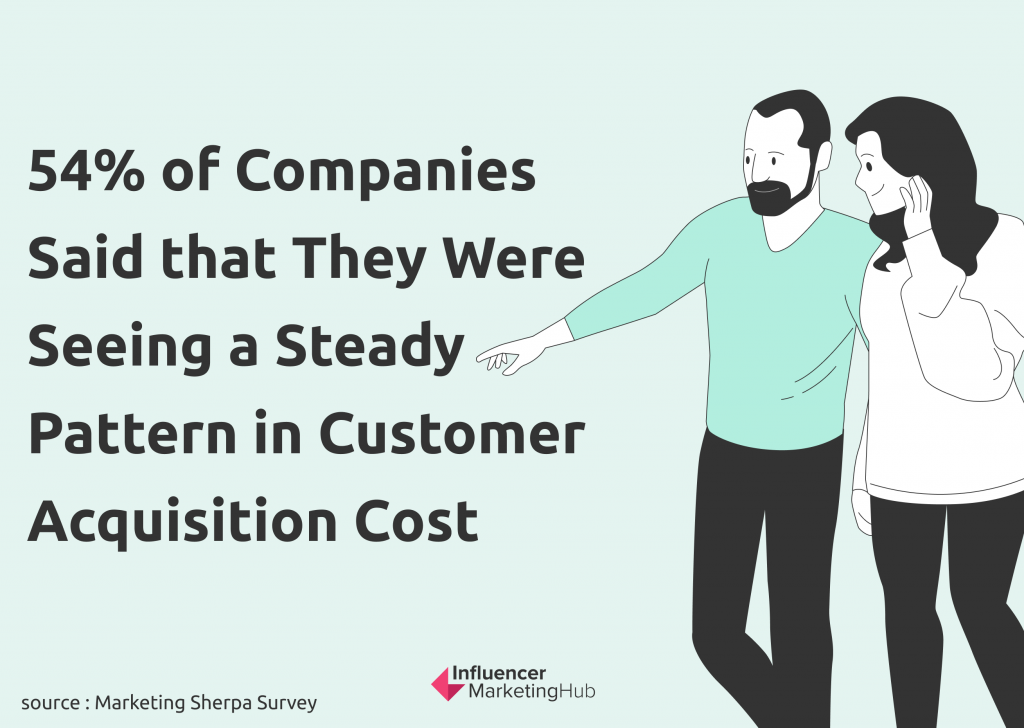
Customer acquisition cost (aka CAC) refers to the cost, such as marketing costs, linked to getting a new customer. Usually, it’s worked out per marketing campaign or for a set period. This info matters because it lets you measure your ROI and, ultimately, figure out if your marketing efforts have paid off.
To work it out, you divide all the marketing costs linked with a specific marketing campaign, for example a referral program, by the number of customers that you gained via that specific campaign.
Measuring your customer acquisition cost is crucial. Though, it shouldn’t be your only focus. For example, your new customers might make only one purchase or they’ll only spend money much later after you’ve spent money on acquiring them. In this case, you’ll also want to measure the customer lifetime value (aka CLV). In short, it gives you an indication of how much a customer is worth to your online business. It can be a good indication of how your business is doing overall and if it’s growing at a steady pace.
Needless to say, your goal should be to keep your customer acquisition cost as low as possible. One of the main ways to do this is to focus on improving your website design. In other words, make sure your site is mobile-responsive, your CTAs are effective, your pages load quickly, etc. You know the drill.
A second factor to consider when trying to minimize your CAC is the cost of the specific channel itself. Improving your website design will help to boost your conversions which in turn will help to reduce the cost, but you can also simply focus on keeping the actual marketing costs as low as possible.
Wrapping Things Up
Customer acquisition remains a key step during each phase of running your online business. From the day you launch, you’ll need a steady flow of new customers to grow. Think of new customers as the oxygen that you breathe. Sure, customer retention is also important, but you need that breath of fresh air if you want to expand your current customer base.
The most effective procedures are straightforward and systemized. You should be able to repeat this process so that getting customers can virtually be done automatically. By knowing where your ideal customer hangs out online and which strategies will help them move down the sales funnel, you can minimize the cost of acquiring new customers.
This won’t happen overnight. So, get ready to try out new approaches continuously so that you end up with the strategies (with the emphasis on plural here) that deliver the best results.
Frequently Asked Questions
How do you work out your customer acquisition cost (CAC)?
To work your customer acquisition cost (CAC), you take the amount your business spent to get new customers (this will be your marketing spend) and divide it by the number of customers that you have acquired. To make sense of this number, you need to compare it to the price of your products. For example, if your average order value is higher, you can afford to spend more on getting new customers. If you’re mostly selling low-ticket items, your CAC should ideally be low.
How can B2B companies improve their customer acquisition?
B2B eCommerce trends for 2021 show that offering educational material can help B2B companies with customer acquisition. B2B companies have started to realize that they need to use SEO if they want to acquire new customers. As a result, more B2B businesses are offering educational material, such as evergreen content that relies on graphics and even video, about their product range to explain who their products are aimed at and how to use it.
What software can you use to manage a referral program?
You can, for example, check out ReferralCandy. It has helped over 30,000 online stores in a wide range of industries with their referral programs. It basically runs your referral program on autopilot. You can use its app to customize your reward options by offering incentives like cash rewards, custom gifts, or store discounts. It also integrates with the main eCommerce platforms and marketing platforms such as Mailchimp and Klaviyo. While it’s a bit more expensive, it’s very easy to use.
Why is user experience important for driving sales?
User experience (UX) is one of the most important features of any successful online business. It plays a crucial role in making sure your website is functional, easy to navigate, and intuitive. A carefully planned user experience that’s unique, yet easy to interact with, can help more potential customers move down the marketing and sales funnel and ultimately keep your customer acquisition cost lower.
How can you use social media to acquire new customers?
Social media is one of the best places for finding and acquiring new customers. You first need to identify the social media platforms where your target audience spends most of their time and then craft a marketing strategy for that specific platform. You can also partner with influencers to reach a bigger audience via social media. Influencers typically have engaged followers who can easily be converted into new customers for your brand.
